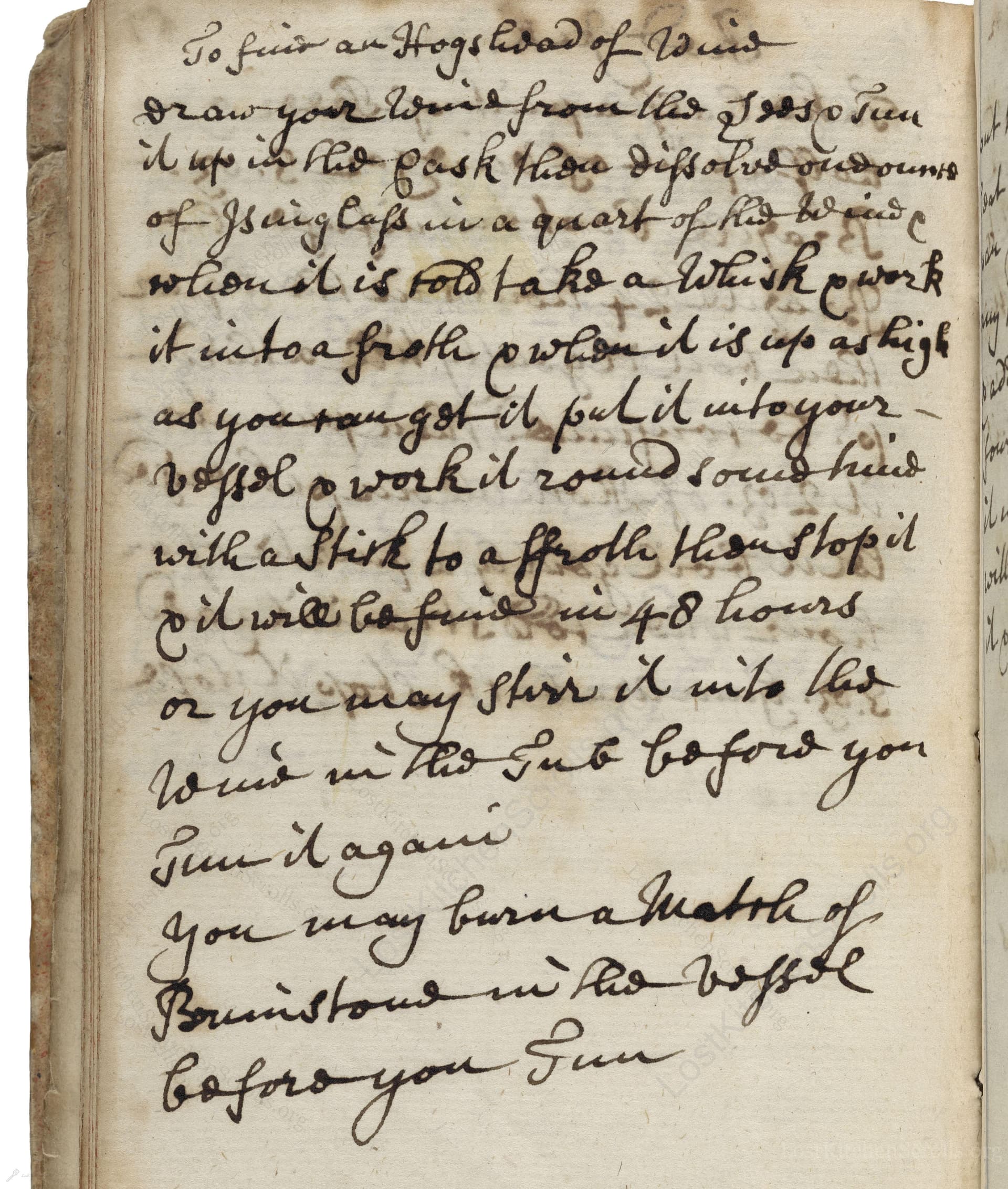To Fine An Hogshead Of Wine
From the treasured pages of Receipt book, Oxfordshire and Warwickshire
Written by Stevens family; Warwick family

To Fine An Hogshead Of Wine
"draw your Wine from the Lees & Tun it up in a fresh Cask then disolve one pound of Jsainglass in a quart of the same wine when it is cold take a Whisk & work it into a froth & when it is up as high as you can get it put it into your vessel & work it round & round hard with a Stick to a froth then stop it & it will be fine in 48 hours or you may stir it into the wine in the Tub before you Tun it again You may burn a Match of Brimstone in the vessel before you Tun"
Note on the Original Text
This recipe is written in concise, practical early 18th-century English. The spelling is old-fashioned—‘Jsainglass’ meaning isinglass, and ‘Tun’ as both verb (to barrel wine) and noun (large cask). Quantities are by weight and volume customary to the period: one pound (450 grams) and one quart (1 liter). Instructions assume the reader is familiar with large-scale winemaking terms, and step-by-step actions like frothing and cask preparation, reflecting a time when recipes were guides for the experienced rather than formulae for novices.

Title
Receipt book, Oxfordshire and Warwickshire (1745)
You can also click the book image above to peruse the original tome
Writer
Stevens family; Warwick family
Era
1745
Publisher
Unknown
Background
A delightful collection of 18th-century culinary wisdom, this manuscript bridges generations of the Stevens and Warwick families. Brimming with time-honored recipes, household tips, and a dash of historical flavor, it’s a savory journey into the kitchens of Georgian England.
Kindly made available by
Folger Shakespeare Library
This recipe comes from the Stevens family papers of Warwick, dating from around 1704 to 1787. During the 18th century, wine was often transported and stored in large wooden vessels called hogsheads, capable of holding about 240 liters. Cloudy or sediment-heavy wine was an ever-present concern, and the art of clarification—or 'fining'—ensured a clear, more palatable drink. Isinglass, derived from fish bladders, was a favored clarifying agent, prized for its gentle effectiveness. Burning sulfur matches was a standard pre-winemaking sanitization method to prevent spoilage by sanitizing the vessel with sulfur dioxide gas. These techniques reflect both the resourcefulness and scientific curiosity of home-based and estate winemakers in Georgian England.

Historically, this process required a large wooden cask (a hogshead), smaller tubs for dissolving the isinglass, wooden paddles or long sticks for stirring, a whisk (handmade or improvised), and sulfur matches for fumigation. Wine was transferred manually, and the act of whisking and frothing relied on arm power rather than mechanical mixers. All tools were made of wood, metal, or natural bristle, with strict observation to cleanliness—or at least, what was considered clean in the 18th century.
Prep Time
30 mins
Cook Time
0 mins
Servings
320
We've done our best to adapt this historical recipe for modern kitchens, but some details may still need refinement. We warmly welcome feedback from fellow cooks and culinary historians — your insights support the entire community!
Ingredients
- 1 pound isinglass (or substitute: gelatin powder)
- 1 quart wine (from the batch to be fined)
- Large cask of wine (approximately 63 gallons in a hogshead)
- 1 sulfur match (brimstone), optional for sterilizing vessel
Instructions
- To clarify ("fine") a large cask of wine, begin by carefully racking the wine off its sediment (lees) and pouring it into a fresh, clean cask.
- Dissolve about 1 pound of isinglass (or gelatin as a substitute) in 1 quart of the same wine.
- Once cool, vigorously whisk the mixture to form a froth.
- Add this foamy mixture back into your wine vessel, stirring it hard and thoroughly with a long stick to incorporate and create another froth.
- Seal the vessel tightly and leave it undisturbed for 48 hours to allow the wine to clear.
- Alternatively, you may mix the whisked isinglass mixture directly into the wine before the wine is transferred to its new cask.
- For further preservation and clarity, you can burn a sulfur match inside the empty vessel just before filling it with wine, following historical methods of sanitization and stabilization.
Estimated Calories
180 per serving
Cooking Estimates
You will need some time to prepare and mix the isinglass or gelatin with wine, and to stir it into the entire cask. Most of the time needed is for the wine to sit and clarify on its own. This recipe makes enough to fine a whole large cask, about 240 liters of wine. Each serving here is about one bottle (750 ml).
As noted above, we have made our best effort to translate and adapt this historical recipe for modern kitchens, taking into account ingredients nowadays, cooking techniques, measurements, and so on. However, historical recipes often contain assumptions that require interpretation.
We'd love for anyone to help improve these adaptations. Community contributions are highly welcome. If you have suggestions, corrections, or cooking tips based on your experience with this recipe, please share them below.
Join the Discussion
Rate This Recipe
Dietary Preference
Main Ingredients
Culinary Technique
Occasions

Den Bockfisch In Einer Fleisch Suppen Zu Kochen
This recipe hails from a German manuscript cookbook compiled in 1696, a time whe...

Die Grieß Nudlen Zumachen
This recipe comes from a rather mysterious manuscript cookbook, penned anonymous...

Ein Boudain
This recipe comes from an anonymous German-language manuscript cookbook from 169...

Ein Gesaltzen Citroni
This recipe, dating from 1696, comes from an extensive anonymous German cookbook...
Browse our complete collection of time-honored recipes



